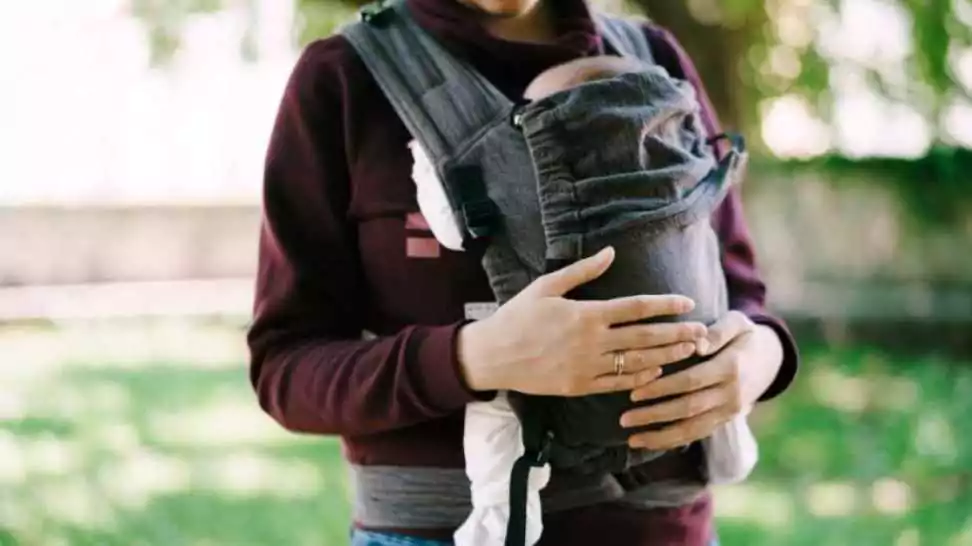How To Carry A Baby In A Sling For New Parents?

Choosing how to carry your baby is a vital aspect of parenting. The tradition of babywearing, particularly using a sling, blends historical significance with modern practicality, offering both emotional and practical benefits.
Rooted in various cultures, babywearing is more than just convenience; it’s a symbol of the enduring parent-child bond. The sling, evolving yet consistent in its purpose, ensures babies stay close and secure.
Safety and bonding are paramount in babywearing. A sling not only provides security but also fosters a unique closeness vital for early development and deepening emotional bonds, mirroring the womb’s comfort.
In this blog, we’ll delve into the advantages of sling use, how to carry a baby in a sling, and guidelines for safe and joyful babywearing. Join us in exploring how a sling can enrich your parenting journey and strengthen the bond with your child.
1 Choosing the Right Sling
Types of Slings: A Variety for Every Need

Selecting the perfect sling is akin to choosing a comfortable pair of shoes; it needs to fit both the wearer and the baby perfectly. There are several types of slings to consider, each with its unique features and advantages.
- Ring Sling: This type of sling consists of a length of fabric with two rings at one end. It is adjustable and perfect for parents who need to wear their baby for varying durations. The ring sling is versatile and can accommodate babies as they grow, from newborns to toddlers.
- Wrap: A wrap is a long piece of fabric that you can tie around your body in various ways. It’s incredibly versatile and offers multiple carrying positions. Wraps are ideal for newborns due to their snugness, offering excellent support for the baby’s back and neck.
- Mei Tai: Combining the simplicity of a buckle carrier with the flexibility of a wrap, the Mei Tai is a traditional Asian carrier. It has a square or rectangular body with straps that tie around the waist and shoulders. It’s a great option for older babies who can hold their heads up.
- Pouch Sling: The pouch sling is a simpler version of the ring sling, without the adjustability. It’s a loop of fabric that creates a pouch for the baby to sit in. It’s compact and great for quick trips, but it’s essential to get the right size for safety and comfort.
Factors to Consider
When choosing a sling, several factors come into play:
- Baby’s Age and Weight: The right sling should accommodate your baby’s size and weight. Newborns need more neck support, while older babies may prefer more freedom of movement.
- Wearer’s Comfort: Consider who will be using the sling most often. The sling should fit well and not cause strain on the back or shoulders.
- Material: Look for breathable, soft fabrics, especially for younger babies. Natural fibres like cotton are often a good choice.
- Ease of Use: Some slings have a steeper learning curve than others. Consider how quickly and easily you can put on and take off the sling.
Tips for Selecting the Right Size and Fabric
- Try Before You Buy: If possible, try on different types of slings with your baby to see what feels most comfortable.
- Seek Adjustable Options: For longevity and versatility, look for slings that can be adjusted as your baby grows.
- Comfort is Key: Choose a fabric that feels comfortable against your skin and is suitable for the climate you live in.
- Safety First: Ensure that the sling supports your baby securely and that their face is always visible and clear of fabric.
2 The Basics of Baby Sling Safety
Embracing the “T.I.C.K.S.” Rule for Safe Babywearing
When it comes to carrying your baby in a sling, safety is paramount. The “T.I.C.K.S.” rule is an essential guide that every parent should follow to ensure their little one’s safety and comfort:
- Tight: The sling should be tight enough to hug your baby close to you. This prevents any slumping that could restrict breathing and ensures comfort for you both.
- In view at all times: You should always be able to see your baby’s face by simply glancing down. The fabric of the sling should not cover their face, and they shouldn’t be turned in towards your body.
- Close enough to kiss: Your baby’s head should be as close to your chin as is comfortable. By being in kissing distance, you can ensure their head is high enough and their airway is clear.
- Keep chin off the chest: Ensure there is always space of at least a finger width under your baby’s chin to avoid any restriction of their breathing.
- Supported back: In an upright carry, a baby should be held comfortably close to the wearer so their back is supported in its natural position, and their tummy and chest are against you.
Regular Checks for Wear and Tear
Just like any baby gear, slings need regular inspection to ensure they are safe to use:
- Check for any rips, tears, or frayed areas in the fabric.
- Inspect the rings in a ring sling to make sure they are not damaged or bent.
- Look for any loose stitching or seams.
- Ensure that any buckles or fasteners are in good working order.
Recognizing Signs of Discomfort or Danger
Being attuned to your baby’s needs is crucial when using a sling. Watch out for these signs:
- Difficulty Breathing: If your baby is in any distress, reposition them immediately. Ensure their airway is clear at all times.
- Overheating: Be mindful of the temperature. Babies can overheat quickly, so avoid too many layers of fabric and check regularly to ensure they are not too warm.
- Unusual Posture: Your baby should not be slumped or in a position where their chin is forced onto their chest.
- Fussiness: If your baby is usually content but seems unsettled in the sling, it could indicate discomfort or a need to change positions.
How to Wear Your Sling
Wearing your sling correctly is crucial for both comfort and safety. Here, we provide a step-by-step guide for different types of slings and tips for adjusting them according to baby size and wearer comfort.
Step-by-Step Guide for Different Sling Types
Ring Sling
- Thread the Fabric: Start by threading the fabric through the rings and spread it evenly.
- Position the Sling: Place the ring sling over one shoulder, with the rings just below your collarbone and the fabric hanging across your torso.
- Insert Your Baby: Gently lower your baby into the pouch, ensuring their legs are in a natural, frog-like position.
- Adjust for Comfort: Pull the tail of the fabric to tighten the sling, making sure your baby is snug and secure.
Wrap
- Find the Center: Locate the centre of the wrap and place it against your stomach.
- Cross the Ends: Bring the two ends behind your back, cross them, and bring them over your shoulders.
- Create the Seat: Form a seat for your baby by widening the fabric over your abdomen.
- Secure Your Baby: Place your baby in the wrap and spread the fabric over their back, ensuring they are close enough to kiss.
Mei Tai
- Tie the Waist Straps: Secure the waist straps of the Mei Tai around your waist.
- Position Your Baby: Hold your baby against your chest and let their legs straddle your waist.
- Secure the Shoulder Straps: Bring the shoulder straps over your shoulders, cross them at your back, and tie them securely under your baby’s bottom.
Pouch Sling
- Wear the Pouch: Slip the pouch sling over your head and one shoulder, creating a pouch for your baby.
- Position Your Baby: Place your baby in the pouch, ensuring they are sitting comfortably in the frog position.
- Adjust for Safety: Make sure the fabric supports your baby’s back and that their face is visible and above the fabric.
Adjusting the Sling

- Baby’s Size: For smaller babies, ensure that the sling provides adequate neck support. For larger babies, allow more room for their legs.
- Wearer’s Comfort: Adjust the sling so that the weight of the baby is evenly distributed, reducing strain on your back and shoulders.
Correct Baby Positioning
- Upright Position: Always keep your baby in an upright position, ensuring their airway is clear.
- Facing the Wearer: The baby should face the wearer, with their face visible and close enough to kiss.
- Leg Position: Babies should maintain a natural, frog-like leg position, with knees higher than their bottom.
3 Mastering Different Carrying Positions
As your baby grows, the way you carry them in a sling will naturally evolve. Mastering different carrying positions not only adds versatility to your babywearing experience but also supports your child’s development at various stages. Here’s how to adapt to these changes safely and comfortably.
Newborn Position: Ensuring Head and Neck Support
For newborns, the primary concern is to provide adequate support for their head and neck since they have limited muscle control.
- Cradle Hold: Use a wrap or ring sling to create a cosy cradle hold. Ensure the baby’s head is supported on the side of the sling, with their body reclining slightly. The fabric should extend from the back of their knees to the nape of their neck.
- Upright Tummy-To-Tummy: In an upright position, keep the newborn’s body against your chest. Ensure their head is close enough to kiss and supported by either the sling fabric or your hand.
Hip Carry for Older Babies: Benefits of This Position

Once your baby has good head and neck control, usually around 4-6 months, the hip carry becomes a viable option.
- Positioning: Position the baby on your hip, using a ring sling or a pouch sling. This carry allows the baby to view the world while maintaining physical contact with you.
- Benefits: Hip carrying aids in developing your baby’s sense of balance and provides an excellent vantage point for them to explore their surroundings, fostering cognitive development.
Back Carry for Toddlers: Safety Tips and Advantages

The back carry is ideal for toddlers who are too heavy to carry in front or on the hip comfortably.
- Using a Wrap or Mei Tai: Place your toddler on your back, ensuring they are sitting high enough to peek over your shoulder. Secure them with the fabric or straps of your chosen sling.
- Safety Tips: Always check that your toddler’s face is clear of fabric and their airway is open. Regularly check the knots and fabric tension to ensure they are secure.
- Advantages: Back carrying allows for greater mobility for the parent and can be more comfortable during longer wearing periods. It also gives toddlers a fantastic view of their surroundings, enhancing their learning and engagement.
4 Tips for Everyday Use
Integrating babywearing into your daily routine can transform your parenting experience, making multitasking easier and strengthening the bond with your baby. Here are some practical tips for navigating everyday activities, dressing appropriately, and overcoming common challenges.
Navigating Daily Activities While Babywearing
Shopping
- Free Hands: Utilise the free hands you have while babywearing to carry shopping bags or push a cart.
- Sling as a Cart Seat: For quick trips, you can use the sling as a makeshift seat in the shopping cart.
- Storage: Some slings come with pockets or storage spaces for small items like keys or a wallet.
Walking
- Posture: Maintain good posture while walking. Avoid leaning back to compensate for the baby’s weight.
- Footwear: Wear comfortable shoes to maintain balance and avoid fatigue.
Household Chores
- Safety: Avoid tasks that involve harmful chemicals or a risk of splashing hot liquids.
- Range of Motion: Engage in tasks that allow you to keep your baby’s safety in check, like folding laundry or light cleaning.
Dressing Appropriately for Babywearing in Different Weather Conditions

- Hot Weather: Choose lightweight, breathable fabrics for both you and your baby. Consider a hat and sunscreen for your baby’s exposed skin.
- Cold Weather: Layer appropriately. Babywearing coats or special covers can provide extra warmth without overdressing the baby.
- Rainy Weather: Use a waterproof sling cover. Ensure your baby’s face is not covered and they have ample airflow.
Dealing with Common Challenges
Breastfeeding in a Sling
- Adjustment: Loosen the sling slightly for comfort. Ensure you maintain eye contact with your baby and that their airway is clear.
- Privacy: Use the tail of the ring sling or a light cloth for privacy if needed.
Soothing a Fussy Baby
- Movement: Gently sway or walk. The rhythmic motion often soothes a fussy baby.
- Talking or Singing: Your voice is incredibly soothing to your baby. Talking or singing can help calm them.
Sling Adjustments
- Regular Checks: Frequently check the sling’s fit and comfort, especially after nursing or when your baby falls asleep.
- Listening to Your Body: If you feel discomfort, adjust the sling’s position. It might take a few tries to find the ideal fit.

5 Taking Care of Your Sling
A well-maintained sling not only ensures safety but also extends the life of the carrier, preserving its comfort and support. Here’s how to properly wash, store, and assess when it’s time to retire your sling.
Proper Washing and Maintenance Tips
- Read the Label: Always check the manufacturer’s instructions. Different materials may require different care methods.
- Gentle Washing: Use a gentle, baby-safe detergent. Hand washing or using a delicate cycle in the machine is often recommended.
- Avoid Harsh Chemicals: Steer clear of bleach or fabric softeners, which can weaken the fabric and irritate your baby’s skin.
- Drying: Air dry your sling, avoiding direct sunlight which can fade the fabric. Avoid tumble drying unless specified safe by the manufacturer.
- Regular Checks: After washing, inspect your sling for any signs of damage or wear.
Storing Your Sling to Preserve Its Shape and Quality
- Avoid Dampness: Ensure your sling is completely dry before storing to prevent mildew.
- Proper Folding: Fold or roll your sling neatly. Avoid hanging ring slings by the rings as this can cause unnecessary strain.
- Cool, Dry Place: Store the sling in a cool, dry place away from direct sunlight to prevent fading and degradation of the fabric.
- Rotation: If you have multiple slings, rotate their usage to evenly distribute wear and tear.
When to Retire a Sling: Safety and Wear Considerations
- Fabric Wear: Look for signs of thinning fabric, holes, or tears, especially near seams and fastenings.
- Ring Integrity: In ring slings, inspect the rings for any cracks or warping.
- Altered Shape: If the sling has lost its shape or has stretched significantly, it may not provide adequate support.
- Safety Concerns: Any sling that poses a safety concern should be retired immediately.
- Consult Experts: If in doubt, consult a babywearing expert or the manufacturer for advice.
6 Wrapping Up
We’ve journeyed through the rich benefits of babywearing with a sling, highlighting the deep bond it fosters and the practicality it offers. Remember, perfecting babywearing is a journey of discovery and adaptation, tailored to the changing needs of your growing child.
Embrace this art with patience and practice. Experiment with various slings and positions to find what resonates best with you and your baby. Trust in your parental instincts; your confidence in babywearing will ensure your baby’s comfort and happiness.
We invite you to share your baby-wearing stories and tips with us. Your experiences are invaluable, offering support and inspiration to fellow parents in the baby-wearing community.
Community Q&A
About This Article
This article has been viewed 109 times.



